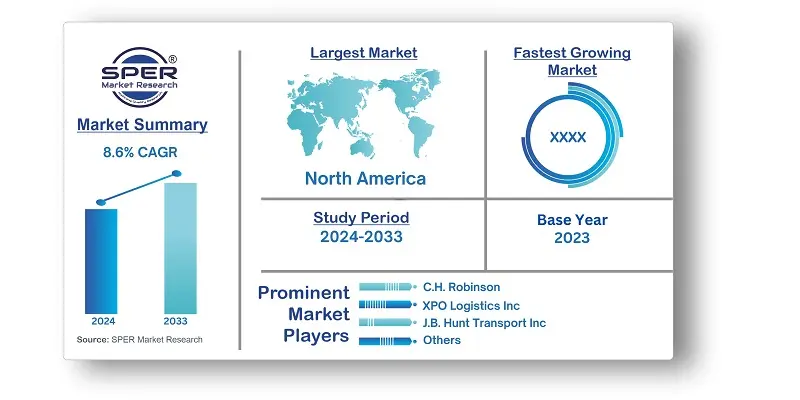
United States Freight Brokerage Market Trends, Share, Size, Revenue, Demand and Future Outlook
United States Freight Brokerage Market Growth, Size, Trend Analysis- By Commute, By Service, By End User- Regional Outlook, Competitive Strategies and Segment Forecast to 2033
| Published: Oct-2024 | Report ID: AMIN24230 | Pages: 1 - 108 | Formats*: |
| Category : Automotive & Transportation | |||
- August 2023: Convoy, a digital logistics provider and freight broking, launched a just-in-time (JIT) trucking service with a promise to deliver within 15 minutes of the scheduled arrival time. Convoy saw an opportunity for a more flexible service that allows shippers to scale up and down in response to rapidly changing conditions. Its new JIT service uses a network of over 400,000 trucks and IT infrastructure to discover carriers that satisfy specific shipper needs.
- Echo Global Logistics Inc. (Echo), a leading provider of technology-enabled transportation and supply chain management services, has announced EchoInsure+, a new and integrated full-coverage cargo insurance product available only to Echo clients. EchoInsure+, in collaboration with insurance group Falvey, provides clients with an easy way to receive best-in-class protection for their LTL shipments via EchoShip, Echo's unique online shipping platform, and Echo's representatives.


| Report Metric | Details |
| Market size available for years | 2020-2033 |
| Base year considered | 2023 |
| Forecast period | 2024-2033 |
| Segments covered | By Commute, By Service, By End-User. |
| Regions covered | Midwest Region, Northeast Region, Southwest Region, and West Region. |
| Companies Covered | CH Robinson, Total Quality Logistics, XPO Logistics Inc, Echo Global Logistics, Worldwide Express, Coyote Logistics, Landstar System Inc, Schneider, SunteckTTS, GlobalTranz, J.B. Hunt Transport Inc, Hub Group, BNSF Logistics LLC, KAG Logistics Inc, Uber Freight. |
- Shippers and Manufacturers
- Retailers and E-commerce Companies
- Logistics and Supply Chain Managers
- Third-Party Logistics (3PL) Providers
- Freight Forwarders
- Transportation Companies
- Small and Medium Enterprises (SMEs)
- Government Agencies and Contractors
- Construction and Infrastructure Companies
- Agriculture and Food Processing Companies
| By Commute: | |
| By Service: | |
| By End User: |
- United States Freight Brokerage Market Size (FY’2024-FY’2033)
- Overview of United States Freight Brokerage Market
- Segmentation of United States Freight Brokerage Market By Commute (Air, Truck, Rail, Water, Others)
- Segmentation of United States Freight Brokerage Market by Service (FTL, LTL)
- Segmentation of United States Freight Brokerage Market by End User (Manufacture and Automotive, Oil and Gas, Mining, Agriculture, Fishing, and Forestry, Construction, Others)
- Statistical Snap of United States Freight Brokerage Market
- Expansion Analysis of United States Freight Brokerage Market
- Problems and Obstacles in United States Freight Brokerage Market
- Competitive Landscape in the United States Freight Brokerage Market
- Impact of COVID-19 and Demonetization on United States Freight Brokerage Market
- Details on Current Investment in United States Freight Brokerage Market
- Competitive Analysis of United States Freight Brokerage Market
- Prominent Players in the United States Freight Brokerage Market
- SWOT Analysis of United States Freight Brokerage Market
- United States Freight Brokerage Market Future Outlook and Projections (FY’2024-FY’2033)
- Recommendations from Analyst
1.1. Scope of the report1.2. Market segment analysis
2.1. Research data source
2.1.1. Secondary Data2.1.2. Primary Data2.1.3. SPERs internal database2.1.4. Premium insight from KOLs
2.2. Market size estimation
2.2.1. Top-down and Bottom-up approach
2.3. Data triangulation
4.1. Driver, Restraint, Opportunity and Challenges analysis
4.1.1. Drivers4.1.2. Restraints4.1.3. Opportunities4.1.4. Challenges
4.2. COVID-19 Impacts of the United States Freight Brokerage Market
5.1. SWOT Analysis
5.1.1. Strengths5.1.2. Weaknesses5.1.3. Opportunities5.1.4. Threats
5.2. PESTEL Analysis
5.2.1. Political Landscape5.2.2. Economic Landscape5.2.3. Social Landscape5.2.4. Technological Landscape5.2.5. Environmental Landscape5.2.6. Legal Landscape
5.3. PORTER’s Five Forces
5.3.1. Bargaining power of suppliers5.3.2. Bargaining power of buyers5.3.3. Threat of Substitute5.3.4. Threat of new entrant5.3.5. Competitive rivalry
5.4. Heat Map Analysis
6.1. United States Freight Brokerage Market Manufacturing Base Distribution, Sales Area, Product Type6.2. Mergers & Acquisitions, Partnerships, Product Launch, and Collaboration in United States Freight Brokerage Market
7.1. United States Freight Brokerage Market Size, Share and Forecast, By Commute, 2020-20267.2. United States Freight Brokerage Market Size, Share and Forecast, By Commute, 2027-20337.3. Air7.4. Truck7.5. Rail7.6. Water7.7. Others
8.1. United States Freight Brokerage Market Size, Share and Forecast, By Service, 2020-20268.2. United States Freight Brokerage Market Size, Share and Forecast, By Service, 2027-20338.3. FTL8.4. LTL
9.1. United States Freight Brokerage Market Size, Share and Forecast, By End User, 2020-20269.2. United States Freight Brokerage Market Size, Share and Forecast, By End User, 2027-20339.3. Manufacture and Automotive9.4. Oil and Gas9.5. Mining9.6. Agriculture9.7. Fishing and Forestry9.8. Construction9.9. Others
10.1. United States Freight Brokerage Market Size and Market Share
11.1. United States Freight Brokerage Market Size and Market Share By Region (2020-2026)11.2. United States Freight Brokerage Market Size and Market Share By Region (2027-2033)11.3. Midwest Region11.4. Northeast Region11.5. Southwest Region11.6. West Region
12.1. CH Robinson
12.1.1. Company details12.1.2. Financial outlook12.1.3. Product summary12.1.4. Recent developments
12.2. Total Quality Logistics
12.2.1. Company details12.2.2. Financial outlook12.2.3. Product summary12.2.4. Recent developments
12.3. XPO Logistics Inc
12.3.1. Company details12.3.2. Financial outlook12.3.3. Product summary12.3.4. Recent developments
12.4. Echo Global Logistics
12.4.1. Company details12.4.2. Financial outlook12.4.3. Product summary12.4.4. Recent developments
12.5. Worldwide Express
12.5.1. Company details12.5.2. Financial outlook12.5.3. Product summary12.5.4. Recent developments
12.6. Coyote Logistics
12.6.1. Company details12.6.2. Financial outlook12.6.3. Product summary12.6.4. Recent developments
12.7. Landstar System Inc
12.7.1. Company details12.7.2. Financial outlook12.7.3. Product summary12.7.4. Recent developments
12.8. Schneider
12.8.1. Company details12.8.2. Financial outlook12.8.3. Product summary12.8.4. Recent developments
12.9. SunteckTTS
12.9.1. Company details12.9.2. Financial outlook12.9.3. Product summary12.9.4. Recent developments
12.10. GlobalTranz
12.10.1. Company details12.10.2. Financial outlook12.10.3. Product summary12.10.4. Recent developments
12.11. J.B. Hunt Transport Inc
12.11.1. Company details12.11.2. Financial outlook12.11.3. Product summary12.11.4. Recent developments
12.12. Hub Group
12.12.1. Company details12.12.2. Financial outlook12.12.3. Product summary12.12.4. Recent developments
12.13. BNSF Logistics LLC
12.13.1. Company details12.13.2. Financial outlook12.13.3. Product summary12.13.4. Recent developments
12.14. KAG Logistics Inc
12.14.1. Company details12.14.2. Financial outlook12.14.3. Product summary12.14.4. Recent developments
12.15. Uber Freight
12.15.1. Company details12.15.2. Financial outlook12.15.3. Product summary12.15.4. Recent developments
12.16. Others
SPER Market Research’s methodology uses great emphasis on primary research to ensure that the market intelligence insights are up to date, reliable and accurate. Primary interviews are done with players involved in each phase of a supply chain to analyze the market forecasting. The secondary research method is used to help you fully understand how the future markets and the spending patterns look likes.
The report is based on in-depth qualitative and quantitative analysis of the Product Market. The quantitative analysis involves the application of various projection and sampling techniques. The qualitative analysis involves primary interviews, surveys, and vendor briefings. The data gathered as a result of these processes are validated through experts opinion. Our research methodology entails an ideal mixture of primary and secondary initiatives.



Frequently Asked Questions About This Report
PLACE AN ORDER
Year End Discount
Sample Report
Pre-Purchase Inquiry
NEED CUSTOMIZATION?
Request CustomizationCALL OR EMAIL US
100% Secure Payment






Related Reports
Our Global Clients
Our data-driven insights have influenced the strategy of 200+ reputed companies across the globe.




















